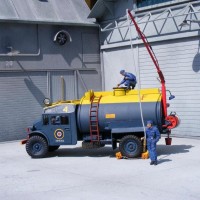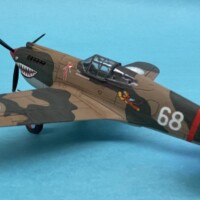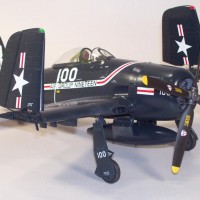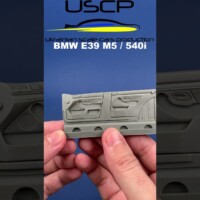Anigrand XP-67 Moonbat
In 1940, the U.S. Army Air Corps issued Request for Proposal R-40C for a new interceptor with long range, high speed, and high altitude. It encouraged bold proposals with new ideas and technologies to upset the status quo. Two dozen entries came in, a raft of radical designs including the motley XP-54, -55, and -56 trio. Like these proposals, the new design firm McDonnell submitted a plan for an aircraft with pusher propellers, but driven by a single engine. Untested and speculative, the proposal did not finish even in the top twenty; however, McDonnell was granted $3000 to re-engineer the aircraft. And so was born the Moonbat.
Given the designation XP-67, the Moonbat had the unfortunate honor of undergoing development during the war. This meant resource and budget constraints, and a general aversion to risk and novelty. Still, the aircraft had a strikingly sleek form, its smooth skin requiring new manufacturing techniques from a nascent company that had never built a complete aircraft before. The engines (two now, with more traditional tractor propellers) were blended into the wing, improving aerodynamics but making them difficult to cool: ground trials in 1943 resulted in engine fires.
The Moonbat's first flight was in 1944: test pilots reported generally good handling, but it was underpowered, failing to achieve speed and climb rate targets. The aircraft exhibited quirky stall characteristics and had an affinity for the Dutch roll (simultaneous tail-wagging and rocking side-to-side); pilots deferred spin tests fearing they'd be unable to pull the craft out of it. These instabilities were later attributed to the advanced aerodynamic principles incorporated into the XP-67's design, which could only be tamed with the advent of modern electronic stability controls.
In September of 1944, the lone prototype suffered another engine fire that spread to the rest of the aircraft, totally consuming it. The pilot escaped safely, but the program was killed.
The Kit
The Anigrand 1/72-scale XP-67 Moonbat is a full resin kit. Apart from a few vacuum formed kits, it's the only option in this scale. Made from Anigrand's conspicuously yellow (and smelly) resin, the panel lines are prominent and the parts are well-cast. My first impression was that this plane is a beast! The fuselage comes in top and bottom pieces (clamshell style), and lots of ballast is needed to keep this guy sitting right. I fit probably around 20 pieces of tungsten shot inside the fuselage and engine nacelles and just barely achieved balance.
Besides the nose of the aircraft, which has a slight droop, the model has good shape. There are some vanes in the engine intakes which don't appear in photos of the real craft and might be removed:
The canopy needs some shaping to sit flush, and I ended up taking too much off to the point that the canopy didn't quite fully enclose the cockpit anymore. I was able to get Anigrand to send me a replacement canopy with my next order, but in the meantime I ended up having to shelve the project for a month or so.
The new canopy fit as badly as the first, but this time I mostly reshaped the fuselage around the cockpit. Once the canopy was sitting flush, I noticed that I would need some filler to nicely seal it against the fuselage. This meant that I would need to mask all the panes since the canopy would be painted all at once along with the body of the aircraft (alternatively, for fairly complex canopies like this one, I might mask a little at a time and paint in stages to avoid having to cut precise masks). Luckily, masking fluid was useful here since the canopy has well-defined edges where the panes meet the frame; while my Humbrol Maskol had dried out to a thickish goo, my Incredible White Mask Liquid Frisket was in great shape and of perfect viscosity for the job:
For base colors I primed in black and then sprayed Mr. Color 304 (Olive Drab) in little squiggles to give a faintly mottled appearance. Mr. Color 306 Gray went on the bottom. After a dark gray panel line wash, I picked a palette of oils for filtering: tan, gray, ochre, greens.
Umber and sepia oils were used for streaks on the bottom:
Thanks for looking!















A superb model and a very informative article, Brian!
Thanks Spiros!
That is one cool looking plane Brian, @bapowellphys and you did a real nice job with this build. I didn't know much about it until I saw a 3D printed 1/32 scale one at a recent local show. His was well done two, and was able to get him to print one up in 1/48th scale for me. It will be a bit of a challenge like a limited run kit but the printing is very well done. I was delighted to see yours here in 1/72nd is well done from what looks like was a challenging kit.
Thank you Walt! Good luck on yours and I look forward to seeing it!
A beautiful build of an interesting aircraft, Brian @bapowellphys
Never heard about this futuristic looking plane.
Thanks for sharing this informative article.
Thanks John. It really is futuristic looking, isn't it? Ahead of its time!
Another airplane that looks better than it was, but you certainly nailed it with this model. Really nice!
Thanks Tom! It seems sadly that there were many planes in this period that looked way better than they were!
Great looking model, Brian. One of my favorite obscure designs. I which one of the Eastern European companies would offer a 1/48 scale.
I always wondered what the results would be if McDonnell had been able to convert the design to a pure jet or turbo-prop.
Thanks Chuck! You're not the first person to lament the lack of 1/48-scale offerings of this plane. Life can be tough for you 1/48ers! 😉
What a sleek, strangely attractive and slightly menacing aircraft design. You did a very good job on this one, Brian, and also an aircraft I hadn't heard of before... :-).
Thanks Paul!
That’s one I never thought I’d see. Well done!
Thanks John. It was a fun build.
The result on this model was worth the work, IMHO. Interesting subject that looks like an early stealth design (though I'm sure it wasn't intended that way).
It does indeed look stealthy, though in the early 1940s I think radar was too nascent a technology to even bother trying to avoid. Sleek it was: too aerodynamic to fly stably without electronic controls!
Excellent build. Some of those Anigrand kits aren't the easiest to build.
Thanks, Dan! Indeed, some are not so easy to build, but this one wasn't too bad.
Very cool! The Moonbat is so unusual looking, but your model is excellent.
Excellent build of an interesting subject - looks awesome!
Brian. Very good-looking model! I'd seen pictures of it; however, I never knew the story behind it. I always figured it was just another post-war experimental aircraft that got tossed to the side in favor of the jet age.
Nicely presented Brian.